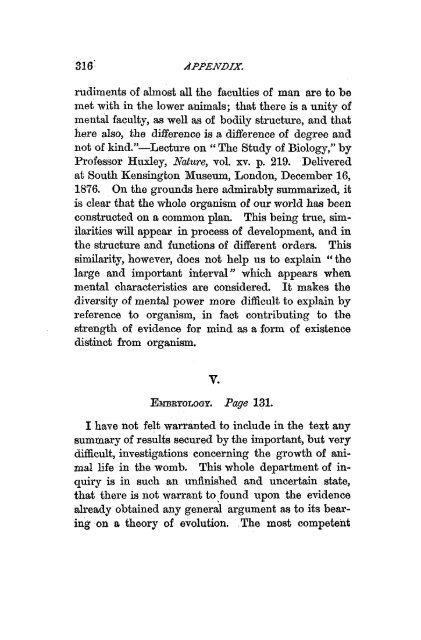The Relation of Science and Religion.pdf - Online Christian Library
The Relation of Science and Religion.pdf - Online Christian Library The Relation of Science and Religion.pdf - Online Christian Library
316' APPENDIX.rudiments of almost all the faculties of man are to bemet with in the lower animals; that there is a unity ofmental faculty, as well as of bodily structure, and thathere also, the difference is a difference of degree andnot of kind."-Lecture on " The Study of Biology," byProfessor Huxley, ATature, vol. xv. p. 219. Deliveredat South Kensington Museum, London, December 16,1876. On the grounds here admirably summarized, itis clear that the whole organism of our world has beenconstructed on a common plan. This being true, similaritieswill appear in process of development, and inthe structure and functions of different orders. Thissimilarity, however, does not help us to explain "thelarge and important interval" which appears whenmental characteristics are considered. It makes thediversity of mental power more d%cult to explain byreference to organism, in fact contributing to thestrength of evidence for mind as a form of existencedistinct from organism.V.EMBRPOLOC~P. Page 131.I have not felt warranted to include in the text anysummary of results secured by the important, but verydifficult, investigations concerning the growth of animallife in the womb. This whole department of inquiryis in such an unfinished and uncertain state,that there is not warrant tofound upon the evidencealready obtained any general argument as to its bearingon a theory of evolution. The most competent
APPENDIX. 317observers admit that they are perplexed by facts ascertained,and confess that they can not as yet offer anexplanation. To others all is as plain as possible; embryologysupplies a convincing proof of the accuracyof an evolution theory; but these are scientific theoristswho see by imagination, and are impatient of uncertainty.There are certain general considerationswhich must interpose difficulties in the way of constructingan argument from Embryology to evolutionof species. (1) The action of environment before birthis altogether different from the action of environmentafter birth. (2) The theory of the evolution of speciesemphasizes this difference by insisting on the strugglefor existence. (3) This difference being admitted, anargument from the one to the other can not hold. Inthe line of discovery the point of chief interest hasbeen the fact that in some cases embryonic life showsa transition through lower forms analogous to lowerorders of animal existence prior to reaching the maturestage when birth occurs. But in connection withthe facts ascertained, two things are to be remarked.(1) Evidence of transitioll is most striking in the historyof animal life developed external to the parentallife, as in the transition from laruce to pupce among insects,and in the changes in the life of the tadpole.(2) If it be admitted that there is a common plan ofstructure for all organism, it is implied that there mustbe similarities in process of development. The questionrequiring answer, therefore, is whether in thegradual development from the germ, any further resemblanceto lower orders appears than is to be anticipatedon the admission of a common plan for organic
- Page 286 and 287: MAN'S PLACE IN THE WORLD. 265tions
- Page 288 and 289: MAN'S PLACE IN THE WORLD. 261lence
- Page 290 and 291: MAN'S PLACE IN THE WORLD. 269As the
- Page 292 and 293: MAN'S PLACE IN THE WORLD. 271.Now t
- Page 294 and 295: MAN'S PLACE IN THE WORLD. 273with a
- Page 296 and 297: LECTURE VIII.RELATION OF SCIENCE TO
- Page 298 and 299: SCIENCE AND DIVINE INTERPOSITION. 2
- Page 300 and 301: SCIENCE AND DIVINE INTERPOSITION. 2
- Page 302 and 303: SCIENCE AND DIVINE INTERPOSITION. 2
- Page 304 and 305: SCIENCE AND DIVINE INTERPOSITION. 2
- Page 306 and 307: SCIENCE AND DIVliZTE INTERPOSITION.
- Page 308 and 309: SCtENCE AND DIVINE INTERPOSITION. 2
- Page 310 and 311: SCIENCE AND DIVINE INTERPOSITION. 2
- Page 312 and 313: SCIENCE AND DZVlNE INTERPOSITION. 2
- Page 314 and 315: SCIENCE AND DIVINE INTERPOSITION. 2
- Page 316 and 317: SCIENCE AND DIVINE INTERPOSITION. 2
- Page 318 and 319: SCIENCE AND DIVINE INTERPOSITION. 2
- Page 320 and 321: SCIENCE A N. DIYXVE INTERPOSITION.
- Page 322 and 323: SCIENCE .4ND DIVlNE INTERPOSITION.
- Page 324 and 325: SCIENCE AND DIVINE INTERPOSITZOU. 3
- Page 326 and 327: SCIENCE AND D/YINE INTHRPOSITION. 3
- Page 328 and 329: SCIENCE' AND DIVINE INTERPOSITION.
- Page 330 and 331: SCIENCE AND DIVINE INTERPOSITION. 3
- Page 332 and 333: APPENDIX.
- Page 334 and 335: 314 APPENDIX.nance to the doctrine
- Page 338 and 339: 318' APPENDIX.structure. There are
- Page 340 and 341: 326 APPENDIX.ments, carbon, hydroge
- Page 342 and 343: 322 APPENDIX.Add to these considera
316' APPENDIX.rudiments <strong>of</strong> almost all the faculties <strong>of</strong> man are to bemet with in the lower animals; that there is a unity <strong>of</strong>mental faculty, as well as <strong>of</strong> bodily structure, <strong>and</strong> thathere also, the difference is a difference <strong>of</strong> degree <strong>and</strong>not <strong>of</strong> kind."-Lecture on " <strong>The</strong> Study <strong>of</strong> Biology," byPr<strong>of</strong>essor Huxley, ATature, vol. xv. p. 219. Deliveredat South Kensington Museum, London, December 16,1876. On the grounds here admirably summarized, itis clear that the whole organism <strong>of</strong> our world has beenconstructed on a common plan. This being true, similaritieswill appear in process <strong>of</strong> development, <strong>and</strong> inthe structure <strong>and</strong> functions <strong>of</strong> different orders. Thissimilarity, however, does not help us to explain "thelarge <strong>and</strong> important interval" which appears whenmental characteristics are considered. It makes thediversity <strong>of</strong> mental power more d%cult to explain byreference to organism, in fact contributing to thestrength <strong>of</strong> evidence for mind as a form <strong>of</strong> existencedistinct from organism.V.EMBRPOLOC~P. Page 131.I have not felt warranted to include in the text anysummary <strong>of</strong> results secured by the important, but verydifficult, investigations concerning the growth <strong>of</strong> animallife in the womb. This whole department <strong>of</strong> inquiryis in such an unfinished <strong>and</strong> uncertain state,that there is not warrant t<strong>of</strong>ound upon the evidencealready obtained any general argument as to its bearingon a theory <strong>of</strong> evolution. <strong>The</strong> most competent



